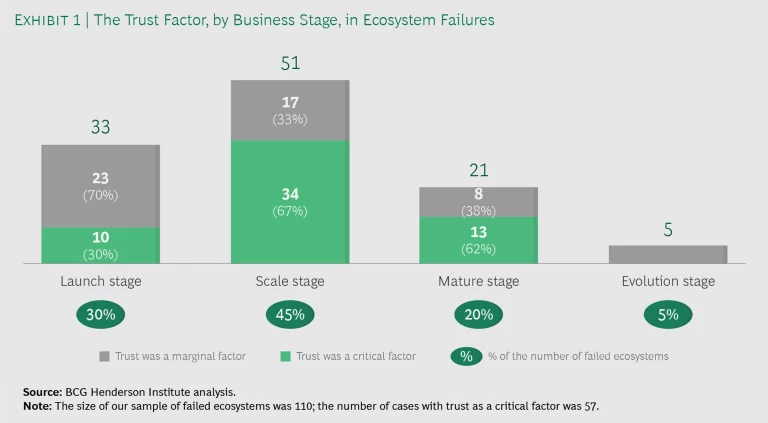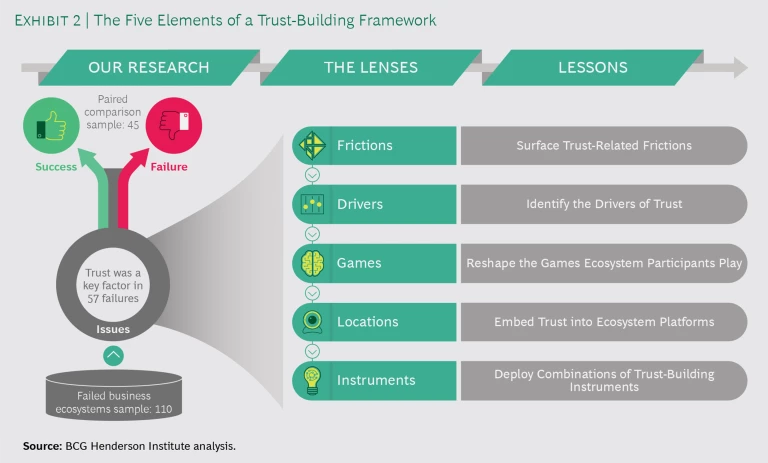Trust, we instinctively realize, is a precious quality that binds relationships, and nowhere more so than in business ecosystems. It’s foundational, but also fragile because all the participants in an ecosystem must learn to work with, and rely on, each other, knowing that no external force compels them to do so. Mutual trust, as much as mutual interest, binds business ecosystems.
Yet few business leaders focus on fostering trust when they create and orchestrate ecosystems. Instead of systematically and specifically incorporating trust into the fabric of their ecosystems, most operate under the assumption that trust will automatically grow over time. However, trust is difficult to build—and easy to erode. When it is neglected, trust withers and distrust blooms, dooming ecosystems to failure.
Data shows that trust-related issues are a major cause of ecosystem failure. The BCG Henderson Institute (BHI) recently conducted one of the first global research projects focused on the role of trust in business ecosystems. (See the sidebar, “Research Methodology.”) Our analysis found that trust was a proximate factor—albeit not necessarily the root cause—in the failure of 57 of the 110 unsuccessful ecosystems that we studied.
Research Methodology
A third of those companies, we concluded, had attributed the failure of their ecosystems—we define “failure” as the dissolution, shrinking to insignificance, or acquisition of an ecosystem for a price below the investments made in it—to making the wrong choices about ecosystem governance standards, rules, and processes. When we analyzed those cases, we found that most of them (94%) had arrived at that conclusion because of trust-related issues. Thus, our research spotlights the critical, and often neglected, role that trust plays in the failure of business ecosystems.
Of course, trust plays just as significant a role in ensuring the success of ecosystems. That became evident from the second step of our study, in which we conducted paired comparisons between 45 of the ecosystems that had failed and one purposely chosen peer ecosystem from each of the industries to which the former belonged. We found that trust mattered a great deal in the success of 73% of the ecosystems that succeeded. Like blood in biological systems, trust is critical to keeping ecosystems alive and working.
Based on our research, this article offers a systematic process that business leaders can use to design and manage trust in ecosystems, thereby setting themselves up for sustained success.
How Trust-Related Issues Fuel Ecosystem Failure—and Success
In our digital era, more and more companies are setting up business ecosystems, but few are likely to succeed. Only 15% of ecosystems have been successful over a meaningful period of time, according to another BHI study. That’s why, we believe, CEOs must anticipate and be prepared to tackle the fallout from trust-related issues in ecosystems.
When there’s no trust, or if the level of trust falls in an ecosystem, participants are less likely to cooperate, and their interactions become transactional. They become increasingly reluctant to do anything for the ecosystem as a whole, and each participant’s focus shifts from growing the ecosystem’s value to capturing value for only itself. As a result, the scope of joint activities shrinks, costs increase, and the growth of network effects slows. Eventually, the ecosystem is unable to grow as fast as rival ecosystems, and it implodes because of the lack of trust.
Trust can be a crippling factor even for global market leaders, and several ecosystems have been stillborn because of trust-related issues. Consider Sony’s electronic book (e-book) reader, the PRS-500, which the company launched in 2006—a full year before Amazon launched the Kindle. Light as a feather, the reader incorporated electronic ink technology that didn’t hurt readers’ eyes. Many experts hailed it as the book industry’s equivalent of the iPod. The PRS-500 offered sharp screen resolution (800 x 600 dpi) and processors that got faster over time. And although the first model could store just 10 MB, Sony soon upgraded it to 256 MB, which ensured that a consumer could store 500 books at a time on the device.
Trust can be a crippling factor even for global market leaders.
Nothing stood between Sony and success, it seemed, except for the trust of book publishers. Gaining that proved to be impossible. Sony had equipped the PRS-500 with a relatively open download mechanism, so users could connect the device to a PC, via the USB port, to access books. The notion that the device would allow copyrighted content to be downloaded openly over the internet—and possibly be hacked—scared book publishers, particularly because Sony’s broadband e-book format was untested. Most decided to stay away from the platform despite sensing that the future of reading was going to be digital.
Twelve months later, Amazon entered the fray with the Kindle, which critics then described as “industrially ugly.” It was larger than the Sony PRS-500, weighed more, and had an inferior screen. However, it was a proprietary device with a closed system that could download content only from Amazon.com. The Kindle prevented buyers from transferring e-books to or from any other device, sharing them, or even connecting to a printer. It enabled Amazon to gain the trust of book publishers, and, by 2014, Sony was forced to announce that it would not make another e-book reader for the consumer market.
Trust is especially relevant in the launch, scale, and maturity stages of an ecosystem’s life cycle—although it is most critical during the scaling phase. At launch, the orchestrator must convince potential participants to join before the ecosystem has proven itself. That requires fostering trust in the orchestrator and the ecosystem’s business model. When the ecosystem is scaling, partners must focus on growing the pie rather than on maximizing their individual slices. Every participant must trust the commitment of the orchestrator and the other players to keep the ecosystem going until it attains critical mass. When the ecosystem is mature, its partners will be dependent on it, so they must trust the orchestrator not to misuse its position of power.
Only 25% of the unsuccessful ecosystems failed after scaling, according to our study, while 30% did so at the launch stage. By far the largest portion (45%) collapsed during the scale phase, with two-thirds of them exhibiting trust-related issues at that stage. (See Exhibit 1.)
Without trust, it’s impossible for ecosystems to mature. Beepi, an automobile buying and selling platform launched in the US in 2014, exemplifies the dilemma in an ecosystem that is scaling. The startup allowed people to buy and sell used cars at the touch of a button by sending a Beepi inspector to conduct a 240-point, two-hour evaluation of every seller’s vehicle. If the vehicle passed the test, Beepi would list it. If someone bought the vehicle, Beepi would transfer the money to the seller, and one of its employees would pick up and deliver the car to the buyer. If the automobile didn’t sell within 30 days, Beepi would buy the vehicle and continue to list it until it sold. By 2015, Beepi was on Forbes’ list of the hottest e-commerce startups in the US and was valued at roughly $550 million.
When an ecosystem is scaling, partners must focus on the pie, not on their individual slices.
Despite the convenience of the process, Beepi could not grow beyond a certain point because of a key issue. Even though Beepi offered a ten-day return window and a warranty, buyers could not inspect or test-drive vehicles before they purchased them. Buying a car entails a large financial outlay, and most buyers weren’t comfortable making the investment sight unseen. They didn’t trust sellers—or Beepi—and wanted the tactile experience of kicking the tires, sitting in the driver’s seat, and driving a car to determine if it met their needs. Beepi didn’t realize it had to earn buyers’ trust by other means, and it folded in 2017.
A Trust-Building Framework
Building trust into an ecosystem and fostering it is critical for success, but it’s a complex process. All the participants in an ecosystem must be involved, but groups of them play distinctive roles, creating and capturing value in different ways. Besides, ecosystem relationships extend from many to many—not from one to many, as in a supply chain. Companies must use a multi-faceted approach to building trust. To help, we’ve developed a trust-building framework that comprises five elements. Like the lenses in a microscope, the elements work as a cohesive system to bring into sharp focus the dynamics of trust in any ecosystem. (See Exhibit 2.)
Business leaders can use the framework to detect trust-related issues and to take the right combination of steps to develop trust. In the rest of this article we discuss the five elements of the framework as a sequence of action steps:
- Surface trust-related frictions.
- Identify the drivers of trust.
- Reshape the games ecosystem participants play.
- Embed trust into platforms.
- Deploy combinations of trust-building instruments.
Surface Trust-Related Frictions
When the participants in an ecosystem run into trust-related issues, the first telltale sign is friction. Trust-related friction manifests itself in two tangible ways: an increase in costs and a loss of opportunity.
Friction leads to an increase in costs because it usually results in churn, which was evident in 62% of the failed ecosystems we studied. Costs rise because of both higher customer churn, as buyers stop engaging with the troubled ecosystem, and greater participant churn, as established participants leave the ecosystem. In order to tackle the fall in demand and to maintain supply, the orchestrator must woo new customers and fresh participants. That leads to restitution or reinstatement costs, which 69% of our sample showed.
Consider, for instance, ride-hailing companies, such as Uber and Lyft, which are struggling to become profitable, despite their popularity, because of the high costs they incur to recruit and retain riders and drivers. On the one hand, because local taxi and ride-sharing companies are trying to create monopolies in their markets, Uber and Lyft have spent millions fighting smaller rivals, attempting to drive their revenues down and their costs up. On the other hand, a high driver-churn rate has forced Uber and Lyft to incur hefty sales, marketing, and promotion costs to keep people driving for them. In an otherwise normal 2019, Uber lost $8.5 billion and Lyft lost $2.6 billion.
Ecosystem leaders must watch out for signs of friction before a cycle of destruction begins.
Friction also shows up as the loss of opportunity, or opportunity costs. Participants may not be able to chase, or fully capitalize on, new opportunities because of trust-related issues, which is bound to affect the ecosystem’s performance. For instance, although RIM’s BlackBerry tried to become a platform company, it failed to recruit app developers to its cause. For years it ignored developers’ demands for a less clunky software platform and a more flexible app approval process. One developer found RIM’s bureaucracy so frustrating that he gave up, and wrote a blogpost, “You Win, RIM!” The post went viral, getting over 30,000 hits on the first day. Losing faith in the ability to generate revenues from RIM, app developers simply shifted to developing apps for Apple’s iOS and Google’s Android platforms. By 2013, RIM was on the auction block.
Ecosystem leaders must watch out for signs of friction before a cycle of destruction begins. Rising friction, if it isn’t nipped in the bud, will curb an ecosystem’s pursuit of economies of scale and limit network effects. That will increase friction and undermine trust even further, derailing the ecosystem’s ability to retain partners.
Trust Takeaway #1: Orchestrators must keep both eyes open for early signs and weak signals of ecosystem trust erosion. They must quickly take countermeasures to foster trust and eliminate distrust before a vicious cycle is triggered.
Identify the Drivers of Trust
Orchestrators must develop an in-depth understanding of the factors that drive trust-based relationships in an ecosystem. Participants usually decide to engage with an ecosystem after evaluating three key criteria: competence, fairness, and transparency.
Competence. Has the ecosystem delivered on its promise to partners and customers? Does it use metrics to constantly evaluate if it has? Competence is, by far, the most prevalent trust driver in the ecosystems we studied, so orchestrators would do well to focus on it. For example, Handy, the US marketplace for residential cleaning, installation, and other home services, realizes that it’s critical that customers perceive the competence of its workers. It rigorously applies several criteria before choosing professionals for tasks, and it makes customer satisfaction ratings public. Initially, Handy even docked the pay of workers who didn’t deliver quality, charging them a fee if they showed up late or left jobs incomplete.
Fairness. Do partners believe that the orchestrator is fair? Does the orchestrator display empathy toward its partners and sometimes place partner interests above its own? If orchestrators don’t do that, a backlash is inevitable—as Apple found. The giant has faced a storm of protest from developers over the fees it charges for listing apps on the App Store. Companies such as Spotify, Basecamp, Blix, Tile, Match, and, recently, Epic Games have all protested, some filing lawsuits. They coordinated their protests, forming the Coalition for App Fairness. Eventually (in January 2021), Apple cut fees from 30% to 15% for small app developers that earn less than $1 million a year from the App Store. That will help 98% of app developers, while reducing Apple’s App Store revenues by less than 5%.
Transparency. Are the orchestrator’s decisions and actions open and unambiguous, so participants believe they are competent and fair? For instance, in order to win the trust of potential partners and encourage them to join its ecosystem, Amazon’s AWS announced a detailed plan in 2014. It covered the future of digital technologies, the cloud, and use cases; the roles other firms could play; and a training and certification program for partners. The high level of transparency helped AWS build an ecosystem that has grown rapidly and incorporates many thousands of partners.
Trust Takeaway #2: An ecosystem that delivers on its value proposition is likely to be trusted, so ensuring value delivery must be the orchestrator’s priority. It must check if every participant in the ecosystem is delivering on, and living up to, its promise every day.
Reshape the Games Ecosystem Participants Play
Game theory suggests that the interactions among ecosystem participants create incentives that shape their behavior. Participants will decide whether or not to cooperate with one another depending on the nature of the incentives. Our study found evidence of games with non-cooperative equilibriums in 71% of failed ecosystems, and games with cooperative equilibriums were evident in 62% of the successful ones.
Orchestrators must incentivize participants to ensure cooperation and discourage uncooperative behavior. If they don’t, mistrust and defection are more than likely. Orchestrators are central to the process because of their relationships with customers, which, our research shows, were key in about 95% of the cases we studied.
Successful orchestrators shape participants’ behavior toward cooperative equilibriums by shifting from a reliance on trust between participants to actively fostering trust in the ecosystem. Airbnb, for instance, doesn’t focus on winning the trust of its hosts and guests. That matters at one level, but what’s more important is that hosts and guests trust each other. Airbnb has designed its platform to ensure that happens; guest ratings and reviews determine hosts’ reputations. Also, by providing host protection insurance, Airbnb has ensured that the workings of its platform build trust in the ecosystem.
Trust Takeaway #3: Orchestrators must reshape the games that ecosystem participants play, so that they become the rationale for cooperation. They can also foster cooperation by ensuring that there is clarity about roles. When participants live up to the expectations set by the orchestrator, it fuels systemic trust.
Embed Trust into Ecosystem Platforms
Trust affects the behavior of all participants in an ecosystem, which plays out in the decline in trust levels in failed ecosystems and the increase in trust in successful ones. In our study, the ecosystems that didn’t work exhibited high levels of trust erosion (44%), poor trust building (29%), or both (27%). Conversely, 76% of the successful ecosystems demonstrated a high level of trust by participants in their ecosystems, while 24% showed a rise in trust between the participants, either alone (11%) or in tandem with measures that embedded trust into the ecosystems (13%).
Trust must never be an after-the-fact consideration; it should be a deliberate consequence of ecosystem design. Leaders should build trust into their ecosystem platforms and governance systems by ridding themselves of the naive belief that trust will arise spontaneously. For instance, when eBay entered China, it assumed that buyers on the platform could trust sellers to deliver products and services. That didn’t happen naturally in many cases, so buyers on eBay mistrusted sellers. They defected to rival platforms such as Alibaba Group’s Taobao, which didn’t make the mistake of assuming that sellers would live up to their promises. Instead, Taobao ensured that they would by embedding trust-building measures into the platform. Typically, it holds the money due to the seller until the buyer confirms that the delivery matches expectations. The measure may appear draconian, but it has ensured cooperation among Taobao’s buyers and sellers, fueling the ecosystem’s success in China.
Trust Takeaway #4: Orchestrators must create ecosystems in which the interactions and relationships between participants generate and sustain trust; they should never leave it to chance. Embedding trust into the workings of platforms ensures that it becomes part and parcel of day-to-day operations.
Deploy Combinations of Trust-Building Instruments
Ecosystem orchestrators can use many kinds of instruments to build trust. Their options include monetary incentives, standards, rules, and, in recent times, digital solutions, such as ratings and blockchain, which have expanded the trust toolkit.
However, the rise of digital platforms has led to the facile conclusion that technology is sufficient to ensure trust in an ecosystem. That’s far from true; there’s no single instrument or technology that can create trust in an ecosystem. In our study, combinations of instruments were essential for success in 90% of ecosystems.
Many kinds of instruments can be combined to ensure cooperation among ecosystem participants. Consider, for instance, HopSkipDrive (HSD), a ride-sharing company for children aged 1 through 12 who must use hired vehicles when traveling without their parents. Parents can access the service through a mobile app and schedule rides up until the night before. HSD offers single-family rides as well as flat-rate pool rides that one family can set up and invite others to join.
Set up by three working mothers, HSD uses a combination of several instruments to ensure that parents can trust HSD’s drivers to ferry their children around safely:
- Checks. HSD’s drivers are mostly women who have at least five years of experience in childcare. CareDrivers, as they’re called, must go through a 15-step screening process. HSD conducts background checks against criminal and sex offender databases, checks driving records, and then interviews and fingerprints the drivers before hiring them.
- Monitoring. HSD uses Zendrive software to monitor driver behavior in real time. It can detect if a driver is talking on a cellphone or texting while driving. During the ride, parents can get updates and track the progress of their child’s journey on a cellphone app.
- Incentives. By offering more rides and higher incomes to better-rated drivers, HSD creates incentives that reduce the possibility of misbehavior and increase the likelihood of driver cooperation.
There’s a science and an art to using instruments to build participants’ trust and ensure the right behavior in an ecosystem. The challenge is to find the combination of instruments that leads to cooperation by all participants, but that’s a subject for another day.
Trust Takeaway #5: Orchestrators would do well to acknowledge that there is no silver bullet that builds trust in ecosystems. They should use a combination of several trust-building instruments that leads to a conducive environment and culture in the ecosystem, fosters cooperation among participants, and ensures the ecosystem’s success over time.
Companies that plan to create ecosystems must design trust into their platforms from the outset. Doing so will, on the one hand, enhance the ecosystem’s operation, because trust catalyzes greater cooperation among participants. On the other hand, trust protects the ecosystem, because it generates the network effects that drive its growth. Thus, ecosystems generate competitive advantage via trust. Above all, ecosystems in which trust continues to rise over time require lower levels of orchestration; each participant influences and is affected by the others, creating an ever-evolving ecosystem that can sustain itself in the long run.








